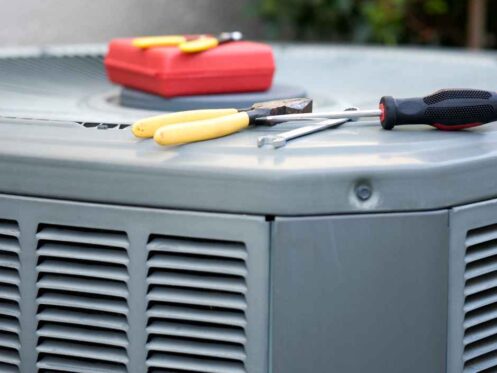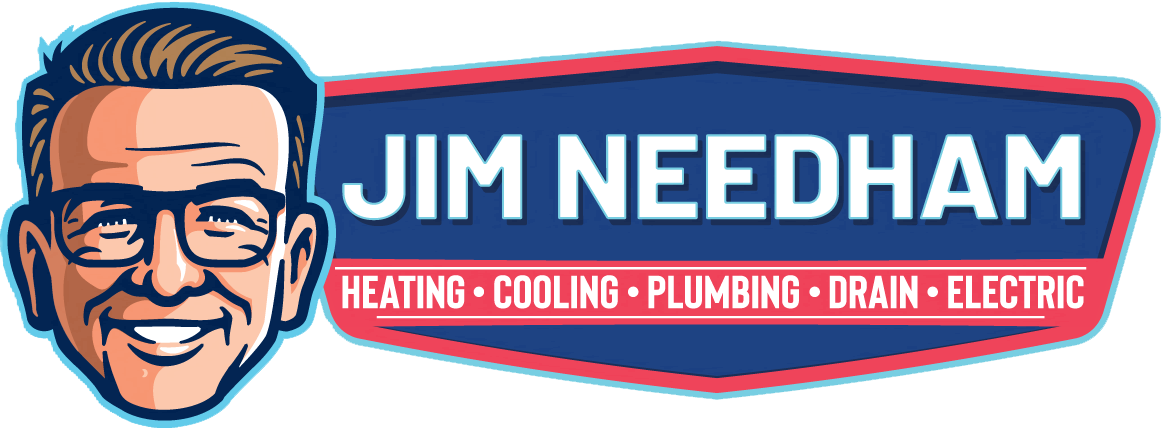When your air conditioner isn’t blowing cold air, it’s more than just an annoyance—it’s a serious disruption to your home comfort. During the summer, homeowners rely heavily on a properly functioning AC to beat the heat. But when the system only blows warm or weak air, it’s a clear sign something isn’t working right. Whether it’s a clogged air filter or a deeper mechanical problem, it’s important to get to the root of the issue quickly. Ignoring the problem can lead to rising energy bills, poor indoor air quality, or even costly system damage.
In this blog, we’ll break down the most common reasons why your air conditioner isn’t cooling, the signs to watch for, how to troubleshoot, and when it’s time to call Jim Needham Heating Cooling Plumbing & Drain.
What Happens When Your Air Conditioner Is Not Blowing Cold Air?
When your air conditioner stops blowing cold air, it’s often a sign that something inside the system isn’t functioning as it should. This can range from airflow restrictions to more complex issues involving refrigerant or electrical components. No matter the cause, the result is the same: your home stays uncomfortably warm, and your AC works overtime trying to keep up.
This issue is especially common when systems haven’t been maintained properly or are aging. Even something as small as a dirty air filter can prevent cold air from circulating. More serious problems—like frozen coils or low refrigerant—can strain your system, reduce efficiency, and eventually lead to breakdowns.
If ignored, the consequences can snowball quickly. Your energy bills may rise, indoor humidity may increase, and your comfort will take a hit. Worse yet, forcing your AC to run while it’s malfunctioning could cause damage to high-cost parts like the compressor.
That’s why understanding what’s going on when your air conditioner isn’t blowing cold air is essential. The sooner you recognize the issue, the sooner you can take steps to restore cool, consistent comfort to your home.
Signs Your Air Conditioner Is Not Cooling Properly
Noticing that your air conditioner isn’t blowing cold air is one thing—but identifying the signs of AC cooling issues early can help prevent bigger problems. Whether it’s subtle changes in airflow or loud noises you haven’t heard before, here are the key symptoms homeowners should watch for:
Common Signs Your AC Isn’t Cooling Properly
- Warm Air from Vents: If your thermostat is set to cool but warm air is blowing, something’s wrong.
- Weak Airflow: Limited air movement from vents could mean a clogged filter, blower issue, or duct problem.
- Frequent Cycling: Your AC turning on and off too often may signal an internal malfunction.
- High Indoor Humidity: One job of your AC is to reduce moisture—if it’s humid, it’s underperforming.
- Inaccurate Thermostat Readings: A faulty or miscalibrated thermostat can keep your AC from reaching your set temperature.
- Unusual Sounds: Hissing, banging, or clicking can indicate issues like refrigerant leaks or mechanical damage.
- Rising Energy Bills: A sudden spike in your electric bill often points to an inefficient system working harder than it should.
These signs can pop up gradually or all at once, but either way, they’re worth paying attention to. Catching them early can save time, money, and discomfort.
What Causes an Air Conditioner to Stop Blowing Cold Air?
If your air conditioner isn’t blowing cold air, it usually comes down to a handful of common issues. Some are simple and easy to fix, while others may require a licensed HVAC technician to diagnose and repair. Understanding why your AC isn’t cooling properly can help you decide on the next steps.
Most Common Reasons Your AC Isn’t Cooling
- Dirty or Clogged Air Filter: A filter packed with dust and debris blocks airflow, making it difficult for cold air to circulate.
- Thermostat Problems: Dead batteries, incorrect settings, or calibration issues can cause your system to run incorrectly or not at all.
- Low Refrigerant Levels: Refrigerant is the lifeblood of your AC system. If it’s leaking or too low, your system can’t effectively cool the air.
- Frozen Evaporator Coils: These coils absorb heat, but when airflow is restricted or refrigerant is low, they can freeze up and stop working.
- Dirty or Blocked Condenser Unit: Your outdoor unit needs to release heat. Dirt, leaves, or nearby shrubs can block this process.
- Leaky or Damaged Ductwork: Even if your AC is working, holes or gaps in your duct system can let cold air escape before it reaches your rooms.
- Electrical or Power Issues: If a breaker has tripped or your AC isn’t receiving full power, only part of the system may be operating.
- Aging AC System: If your unit is more than 10–15 years old, worn-out parts or general wear and tear may be affecting its performance.
Knowing these causes can help you pinpoint what’s going wrong—or at least give your HVAC technician a helpful head start.
How to Fix an AC That’s Not Blowing Cold Air
Once you’ve identified that your air conditioner isn’t cooling your home, the next step is figuring out how to fix it. Some solutions are simple enough for a handy homeowner, while others are best left to the professionals. Here’s a breakdown of what you can do—and when it’s time to call in expert help.
DIY Fixes for Air Conditioners That Aren’t Cooling
- Change the Air Filter: Replacing a dirty filter is one of the easiest and most effective ways to restore airflow.
- Check Your Thermostat: Make sure it’s set to “cool,” not just “on” or “auto,” and replace the batteries if needed.
- Clear Around the Outdoor Unit: Trim back any bushes, clean off debris, and ensure the condenser has at least two feet of breathing room.
- Inspect Vents: Make sure no furniture or rugs are blocking airflow from vents inside the house.
- Reset the Breaker: If your AC isn’t turning on, check your breaker box and reset any tripped switches.
- Defrost the Coils: If you suspect the coils are frozen, turn off the system for a few hours to allow them to thaw, then restart.
When to Call a Professional HVAC Technician
- Low Refrigerant or Suspected Leak: Handling refrigerant requires EPA certification and special tools.
- Electrical Issues: If fuses are blowing or breakers trip repeatedly, it’s a safety issue that needs expert evaluation.
- Frozen Coils That Keep Coming Back: Persistent coil freezing could indicate deeper system imbalances or airflow issues.
- Damaged Ductwork: Professionals can use pressure tests or cameras to find leaks hidden behind walls or ceilings.
- Unresponsive System: If your AC won’t start or runs without cooling, it could be a sign of compressor failure or control board problems.
- Old or Inefficient Equipment: If repairs are adding up and your system is aging, it may be time for a full replacement.
If you’re ever unsure, it’s always better to have a qualified AC repair technician from Jim Needham Heating Cooling Plumbing & Drain assess the situation safely and thoroughly.
Tips to Prevent Your AC From Losing Its Cooling Power
The best way to avoid the headache of an air conditioner that isn’t blowing cold air is by staying ahead of the problem. Regular maintenance and smart usage habits can extend the life of your system and keep it cooling efficiently all summer long. Here are some easy ways to prevent AC cooling issues before they start:
- Change Air Filters Regularly: Replace your filter every 1–3 months to ensure proper airflow and avoid system strain.
- Schedule Annual Maintenance: Professional tune-ups can catch small problems before they become major breakdowns.
- Keep the Outdoor Unit Clean: Remove leaves, debris, and dirt from around your condenser to improve heat exchange.
- Check the Thermostat Settings: Set your thermostat correctly and consider upgrading to a programmable or smart model.
- Seal and Insulate Ducts: Proper ductwork ensures cool air reaches every room without loss.
- Keep Vents Open and Unblocked: Closed or obstructed vents can reduce airflow and put unnecessary strain on the system.
- Use Ceiling Fans to Circulate Air: Fans help distribute cool air more evenly throughout your home.
With just a little upkeep and awareness, you can help your AC run more efficiently and avoid unexpected repairs.
Wrap-Up: Don’t Let a Warm House Ruin Your Summer Comfort
If your air conditioner isn’t blowing cold air, it’s not just an inconvenience—it’s a problem that can quickly spiral into higher energy bills, bigger repairs, and uncomfortable living conditions. By learning the signs of cooling issues, understanding what causes them, and knowing when to take action, you can keep your home comfortable and your system running smoothly.
Some fixes are quick DIY wins, but for more complex problems—like refrigerant leaks, frozen coils, or persistent airflow issues—it’s best to trust the pros. Regular maintenance and smart prevention can go a long way in avoiding cooling problems in the first place.
At Jim Needham Heating Cooling Plumbing & Drain, we’re here to help homeowners stay cool and stress-free all summer long. If your AC isn’t performing like it should, don’t sweat it—schedule an appointment with our expert team today and get back to comfort fast.

